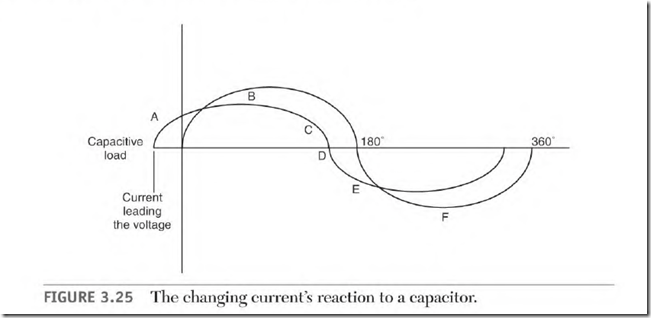Capacitance is the term used to describe a component’s or circuit’s ability to store electrical energy.
Capacitive reactance is the amount of effect capacitance has on a circuit. Like inductive reactance, capacitive reactance has resistance to current flow.
Capacitor Function
A capacitor stores power in electrostatic form. As a fully charged capacitor is discharged, power is produced. Unlike inductive reactance, as Hz go up, amperes also go up.
The sine wave in Fig. 3.25 shows how the electrons flow in a capacitor. As the voltage goes up at point A, electrons are pulled into the capacitor plate as if there is a vacuum. When the voltage reaches peak value (B), the electron (current) flow stops because the voltage potential on the capacitor
plate equals the voltage of the sine wave. As the voltage value drops (C), the electrons are expelled from the capacitor plate as though they are under pressure. At point D in the sine wave, there is no voltage potential, so there is no electron flow. As the voltage polarity reverses (E), the electrons are pulled onto the opposite plate as though there is a vacuum. At the peak of this half of the cycle (F), electron movement stops. As the voltage drops toward zero, the electrons leave the plate (as though under pressure) until the voltage drops to zero. The vacuum-pressure action results in a separation of the voltage and the current, causing the current to lead the voltage. This is a line condition with a leading power factor. (The current leads the voltage.)
Capacitor Value
The capacitance rating of a capacitor is measured in microfarads (mfd or VI). (v is used instead of mfd on the side of capacitors.) A capacitor’s rating is affected by the area of its plates and the thickness of its dielectric (insulation between plates).
Increasing the plate area increases the mfd rating. When capacitors are connected in parallel, the plate area is increased. The capacitor’s mfd ratings are added together to get the total capacitance value in a parallel connection.
When two identical capacitors are connected in series, the thickness of their dielectric is doubled. This connection reduces the total capacitance value. To get the capacitance value of identical capacitors connected in series, divide the value of one capacitor by the number of them. For example, for two 300-mfd capacitors connected in series, 300 mfd + 2 (capacitors) = 150 mfd.
Capacitors for Single-Phase Motors
There are many types of capacitors. The two types discussed here are used in single-phase motors—oil-filled and electrolytic capacitors (Fig. 3.26). Both have two plates made of aluminum. The aluminum plates are separated by insulation called a dielectric. The plates and dielectric are rolled up tightly and placed in a container.
